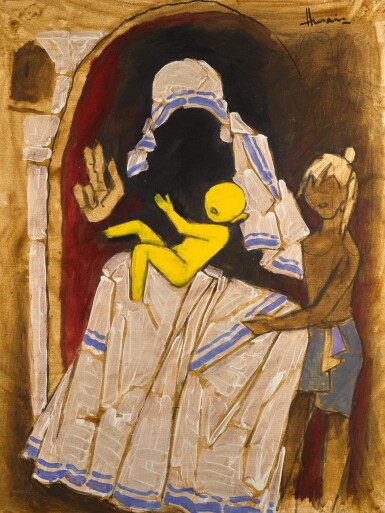Modern and Contemporary South Asian Art
Modern and Contemporary South Asian Art

PROPERTY FROM THE COLLECTION OF MR. AND MRS. RACKOW
MAQBOOL FIDA HUSAIN | UNTITLED (MOTHER TERESA)
Auction Closed
September 29, 03:32 PM GMT
Estimate
40,000 - 60,000 GBP
Lot Details
Description
PROPERTY FROM THE COLLECTION OF MR. AND MRS. RACKOW
MAQBOOL FIDA HUSAIN
1913 - 2011
UNTITLED (MOTHER TERESA)
Acrylic on canvas
Signed 'Husain' upper right
96.5 x 73.7 cm. (38 x 29 in.)
Painted in 1991
Acquired directly from the artist in Bombay, 1991
Mr. Thomas and Mrs. Henriette Rackow lived in Bombay between 1989 and 1993. Mr. Rackow worked for Siemens which brought them to India for those years. They met Husain through the former mayor of Bombay at the time, Mr. Murli Deora. Husain visited their home and painted this lot for them.
“I was walking through the streets of Calcutta with my pen and my sketch book, when I saw her angelic form, draped in a white sari, her head covered, her face suffused with tender love and her posture discerning humility. She was comforting sick children and old people by holding their hands and praying for them. I felt that scene of love in every pore of my body. I just could not move away from there. That very day, I resolved to make a portrait of her but it would need a lot of study. Her personality, her presence and her work are so great; I cannot depict her in realistic form.” (Artist statement, R. Siddiqui, In Conversation with Husain Paintings, New Delhi, 2001, pp. 202-203)
Maqbool Fida Husain first painted the revered figure of Mother Teresa in 1980, shortly after she had been awarded the Noble Peace Prize and the Bharat Ratna, India’s highest civilian award. He was deeply moved by her compassion and charity towards the vulnerable, sick and poverty-stricken, and he tirelessly revisited her as a subject in his painting over the following decades. The artist recalls “I have tried to capture in my paintings what her presence meant to the destitute and the dying, the light and hope she brought by mere inquiry, by putting her hand over a child abandoned in a street.” (M. F. Husain quoted in Y. Dalmia, The Making of Modern Indian Art: The Progressives, New York, 2001, p. 116)
In Husain’s representations of Mother Teresa, she is depicted faceless, recognisable by her trademark blue-trimmed white sari. In some instances, as in the current lot, the only visible feature of her form is a disembodied, gesturing hand, another important motif seen throughout Husain’s body of work. Mother Teresa is often accompanied by the weak and vulnerable in his paintings; here, she is shown holding a baby, rendered in flat shapes of vibrant yellow, and alongside a doting street child.
In painting Mother Teresa, Husain was able to explore an enduring and intensely personal theme of his work: motherhood. Showing her as a faceless entity and in the presence of children, the artist alludes to the void left by his own mother’s early passing, and more specifically, his inability to remember her face. “My mother Zainab died when I was two years old… Can anyone make up for the loss of a mother? I don’t even have a picture of her. She refused to get herself photographed… Sadly I have nothing which remotely resembles or reminds me of my mother. She is just a name to me, not even a memory.” (M. F. Husain quoted in Y. Dalmia, The Making of Modern Indian Art: The Progressives, Oxford University Press, Delhi, 2001, p. 111)
